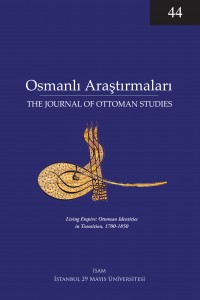Not
Yıl 2014,
Cilt: 44 Sayı: 44, 1 - 9, 15.04.2014
Öz
Biography is back with a vengeance in the writing of history under the guise
of the exploration of “identity” in late multi-ethnic imperial settings. We are experiencing
an age of tremendous upheaval and angst about the future of the post
WWII nation-state which has led in turn to questions about the nature of subjecthood,
citizenship and community especially in the pre-modern world, just one
reason that the study of the Ottoman Empire has become such a growth industry.
Kaynakça
- Aksan, Virginia. “The Question of Writing Pre-Modern Biographies of the Middle East,” in Mary Ann Fay, ed., Auto/Biography and the Creation of Identity and Community in the Middle East (New York: Palgrave, 2001), 191-200.
- Aksan, Virginia. “Who was an Ottoman? Reflections on ‘Wearing Hats’ and ‘Turning Turk,’” in Barbara Schmidt-Haberkamp, ed. Europe und die Türkei in 18. Jahrhundert / Europe and Turkey in the Eighteenth Century (Göttingen: Unipress, 2011), 305-18.
- Burbank, Jane and Frederick Cooper, Empires in World History: Power and the Politics of Difference (Princeton: Princeton University Press, 2010).
- Ergul, Aslı. “The Ottoman Identity: Turkish Muslim or Rum?” Middle Eastern Studies 48:4 (2012). 629-45.
- Kırlı, Cengiz. Sultan ve Kamuoyu: Osmanlı Modernleşme Sürecinde “Havadis Jurnalleri” (1840-1844) (Istanbul: İş Bankası Kültür Yayınları, 2009).
- Hanssen, Jens. “‘Malhamé – Malfamé’”: Levantine Elites and Transimperial Networks on the Eve of the Young Turk Revolution,” International Journal of Middle East Studies 43 (2011), 25-48.
- Petrov, Milan V. “Everyday Forms of Compliance: Subaltern Commentaries on Ottoman Reform, 1864-1868,” Comparative Studies in Society and History 46:4 (2004), 730-59.
- Phillou, Christine. “Communities on the Verge: Unraveling the Phanariot Ascendancy in Ottoman Governance,” Comparative Studies in Society and History 51:1 (2009), 151-81.
- Salzmann, Ariel. “A Travelogue Manqué: the Accidental Itinerary of a Maltese Priest in the Seventeenth Century Mediterranean?” in Adnan A. Husain and K. E. Fleming, eds., A Faithful Sea: The Religious Cultures of the Mediterranean (Oxford: Oneworld, 2007), 149-72.
- Yılmaz, Şuhnaz, and İpek Yosmaoğlu, “Fighting the Spectres of the Past: the Dilemmas of Ottoman Legacy in the Balkans and the Middle East,” Middle Eastern Studies 44:5 (2008), 677-93.
Yıl 2014,
Cilt: 44 Sayı: 44, 1 - 9, 15.04.2014
Öz
Kaynakça
- Aksan, Virginia. “The Question of Writing Pre-Modern Biographies of the Middle East,” in Mary Ann Fay, ed., Auto/Biography and the Creation of Identity and Community in the Middle East (New York: Palgrave, 2001), 191-200.
- Aksan, Virginia. “Who was an Ottoman? Reflections on ‘Wearing Hats’ and ‘Turning Turk,’” in Barbara Schmidt-Haberkamp, ed. Europe und die Türkei in 18. Jahrhundert / Europe and Turkey in the Eighteenth Century (Göttingen: Unipress, 2011), 305-18.
- Burbank, Jane and Frederick Cooper, Empires in World History: Power and the Politics of Difference (Princeton: Princeton University Press, 2010).
- Ergul, Aslı. “The Ottoman Identity: Turkish Muslim or Rum?” Middle Eastern Studies 48:4 (2012). 629-45.
- Kırlı, Cengiz. Sultan ve Kamuoyu: Osmanlı Modernleşme Sürecinde “Havadis Jurnalleri” (1840-1844) (Istanbul: İş Bankası Kültür Yayınları, 2009).
- Hanssen, Jens. “‘Malhamé – Malfamé’”: Levantine Elites and Transimperial Networks on the Eve of the Young Turk Revolution,” International Journal of Middle East Studies 43 (2011), 25-48.
- Petrov, Milan V. “Everyday Forms of Compliance: Subaltern Commentaries on Ottoman Reform, 1864-1868,” Comparative Studies in Society and History 46:4 (2004), 730-59.
- Phillou, Christine. “Communities on the Verge: Unraveling the Phanariot Ascendancy in Ottoman Governance,” Comparative Studies in Society and History 51:1 (2009), 151-81.
- Salzmann, Ariel. “A Travelogue Manqué: the Accidental Itinerary of a Maltese Priest in the Seventeenth Century Mediterranean?” in Adnan A. Husain and K. E. Fleming, eds., A Faithful Sea: The Religious Cultures of the Mediterranean (Oxford: Oneworld, 2007), 149-72.
- Yılmaz, Şuhnaz, and İpek Yosmaoğlu, “Fighting the Spectres of the Past: the Dilemmas of Ottoman Legacy in the Balkans and the Middle East,” Middle Eastern Studies 44:5 (2008), 677-93.
Toplam 10 adet kaynakça vardır.
Ayrıntılar
| Birincil Dil | İngilizce |
|---|---|
| Bölüm | Makaleler |
| Yazarlar | |
| Yayımlanma Tarihi | 15 Nisan 2014 |
| Yayımlandığı Sayı | Yıl 2014 Cilt: 44 Sayı: 44 |


